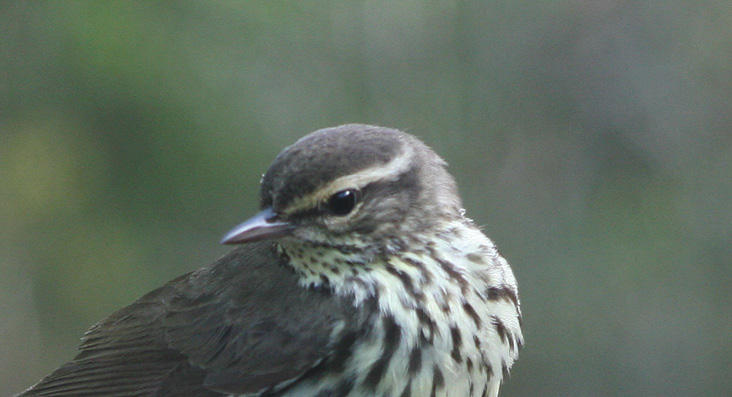Wayne R. Petersen

Wayne R. Petersen
This issue's mystery species features a songbird with a streaked (or possibly spotted) breast, a speckled throat, a prominent supercilium (stripe over the eye), a solid brown cap and back, and a sharp pointed bill. Among the most likely identification possibilities for this mystery species are American Pipit, some kind of warbler, or possibly a sparrow, although the sharp pointed bill is not that of seedeater like a sparrow, so the best bet is probably an American Pipit or a warbler.
Despite a superficial resemblance to a pipit, the mystery species can readily be eliminated as a pipit by its obviously speckled throat, bold whitish supercilium extending in front of the eye to the base of the bill, dark solid back color, and no hint of wing-bars. With a pipit as an unlikely candidate, a warbler is the most likely possibility.
One of the ways that warblers can be separated into groups is to consider those with streaked or spotted underparts and those with plain or unmarked underparts. Assuming that the mystery species is a warbler, then clearly it fits into the group with streaked or spotted underparts. Given that the mystery image lacks obvious wing-bars, the identification options are limited to only two or three possibilities: Ovenbird, Louisiana Waterthrush, and Northern Waterthrush. Ovenbird can readily be eliminated because Ovenbirds lack a broad white supercilium and a spotted throat, and they have a rusty orange crown patch and a bold white eye ring. This leaves the identification of the mystery warbler as a choice between Louisiana Waterthrush and Northern Waterthrush.
Although the two waterthrush species are unlike other warblers in some ways, separation of the two species is often not straightforward. The Louisiana Waterthrush has a broader and wider white supercilium than the Northern species, along with an unspotted white throat, generally wider and less dense streaking on its breast, and a whiter basal coloration to its underparts. By contrast, Northern Waterthrushes typically have a narrower supercilium than Louisianas, and the supercilium typically narrows behind the eye, unlike the bolder and longer white stripe of a Louisiana Waterthrush, which typically widens behind the eye. Additionally, Northern Waterthrushes have a denser necklace of breast streaks than Louisianas, and when observed at close range the basal coloration of their underparts and the eye stripe coloration of a Northern Waterthrush is often yellowish instead of pure white, although this feature is sometimes variable. Collectively, these features identify the pictured mystery warbler as a Northern Waterthrush (Parkesia noveboracensis).
In addition to the plumage features described above, the two waterthrush species can readily be distinguished by their distinctive songs, and during the breeding season the Northern's preference for bogs and swampy forests with standing water versus the Louisiana's affinity for more upland stream sides and running water are helpful indicators of which species is which.
In Massachusetts the Northern Waterthrush is a fairly common spring and fall migrant inland and along the coast, with breeding residents arriving in late April, usually a little later than breeding Louisiana Waterthrushes. In fall Northern Waterthrushes are on the move by mid-August, and most have left Massachusetts by the end of September.
The author photographed this Northern Waterthrush on May 21, 2008, at the bird banding station on Plum Island, Massachusetts.
Wayne R. Petersen